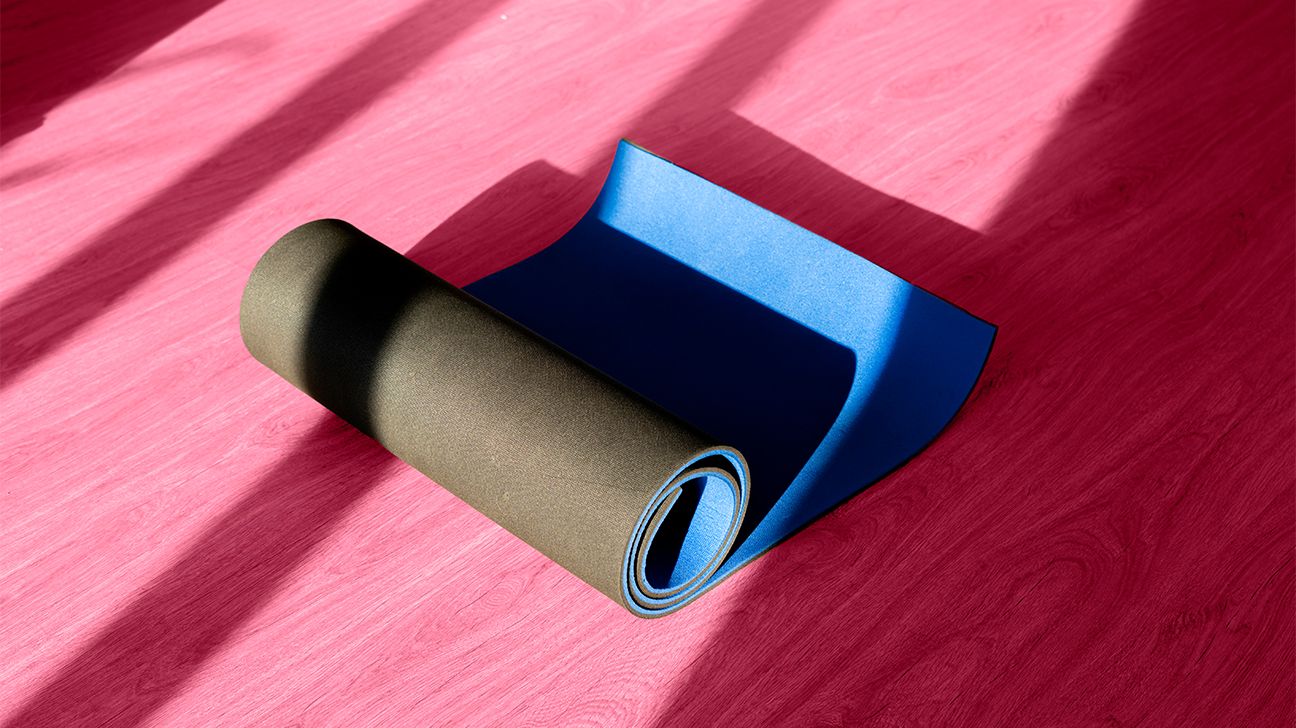Yoga mats are designed to get stepped on and sweat on. This makes them a great breeding ground for bacteria, fungi, and other yucky stuff. To reduce the ew factor, you should clean your yoga mat on the reg. Here’s how.
Bonus: We also have the deets on daily yoga mat maintenance and the best products to use.

From Downward Dog to Cobra Pose, your mat gets a lot of skin-on-skin contact. While certain brands absorb more body odor than others, all types of mats can get gunky. That said, regular disinfecting and occasional deep cleaning is a must.
The best way to keep your mat clean and healthy is to wipe it down with a disinfecting solution after each sweat sesh. Then give it a deep cleaning once a month, depending on how often you practice yoga.
BTW, here’s the difference between cleaning and disinfecting:
- Disinfecting means using an antibacterial solution to crush lingering germs or fungus (peace out, athlete’s foot!). You should do this after each use.
- Deep cleaning is when you physically wash or wipe it down. This helps remove grit like dirt from the floor, oil from your face or hair, and sweat from… everywhere? You should deep clean your mat about once a month.
Your yoga mat is prob teeming with tiny life. It spends a ton of time on the floor, where your tootsies track in dirt and microbes. It also soaks up human sweat, a breeding ground for bacteria. Icky, right?
Here’s how to lightly disinfect your mat, which helps kill germs and remove viruses:
- Unroll your mat.
- Thoroughly spritz one side with a cleansing spray.
- Use a clean towel to wipe the mat and soak up any excess liquid.
- Flip the mat to the other side and repeat steps 2 and 3.
- Dry it out over a chair or railing before rolling it up again.
If you lightly disinfect your yoga mat on the reg, you won’t need to deep-clean it that often. Once a month usually does the trick, unless you notice a weird smell or grit buildup.
Here’s how to deep clean your yoga mat:
- Fill a spray bottle or bucket with warm water.
- Add a few drops of liquid dish soap.
- Spray the mat with the mixture.
- Use a clean cloth to gently scrub the mat in a circular motion.
- If you have a closed-cell mat, rinse and wipe it dry with a clean towel. If you have an open-cell mat, submerge in clean water or rinse thoroughly.
PSA: Bacteria *love* warm, moist spaces. So, make sure your mat is bone dry before you put it away.
A splash of water isn’t gonna cut it. To properly clean or disinfect a yoga mat, you’ll need to use a cleaning product. Here are some top-notch options:
- Manduka Yoga Mat Wash and Refresh
- ASUTRA Natural & Organic Yoga Mat Cleaner
- Black Diamond Stoneworks Yoga Mat Spray Cleaner
- Mind Over Lather 100% Natural Yoga Mat Cleaning Spray
- Vapor Fresh Natural Sports Cleaning and Deodorizing Spray
You can also make a dope DIY cleansing wash at home. Ingredients like apple vinegar and witch hazel have natural antibacterial properties. And to keep things smelling fresh AF, you can add a few drops of your fave essential oils. Just be sure you choose ingredients you’d be comfortable putting on your skin.
Here’s a simple yoga mat cleanser you can make at home:
- 1/2 cup witch hazel or vinegar (you can also combine 1/4 cup of each)
- 2 to 3 cups filtered water
- 13 drops of essential oil
Simply shake the ingredients in a spray bottle and you’re good to go.
Can you use bleach to clean a yoga mat?
It’s not a good idea. Bleach can cause skin, eye, and lung irritation. It can also erode your mat faster than more natural cleansers. Plus, your mat will reek of Clorox which isn’t very Zen. So be kind to your body and use skin-friendly cleaners on your mat.
Actually, yes! Yoga mats come in open-cell and closed-cell varieties.
- Open-cell yoga mats are porous. They absorb more sweat, which makes them more grippy — but also harder to deep-clean.
- Closed-cell yoga mats are nonporous. They’re easier to clean, but they also tend to be slick and more expensive.
Yoga mats can also be made from several materials, including:
- natural rubber
- polyvinyl chloride (PVC)
- thermoplastic elastomer (TPE)
- blends like cork and rubber or jute and PVC
P.S. Some yoga mats can be washed in a front-loading washing machine. But you should def check the manufacturer’s website for specific cleaning instructions.
Heck yes, it does.
Some folks place a towel on top of their mat before practicing yoga. The towel offers extra grip *and* acts as a sweat-absorbing barrier between your skin and mat. Plus, it’s easier to toss a towel in the wash than thoroughly disinfect a mat.
Still, a towel can only absorb so much. A towel might help lengthen the time between deep cleanings, but it won’t do anything to ward off bacteria or fungi.
Yoga mats can absorb sweat and oil during your practice. That’s why you should wipe your mat with a gentle disinfecting solution after each session. You should also give it a deep clean at least once a month, especially if you use it often.
Reminder: Yoga mats come in different thicknesses and materials. This can affect the way you should clean or disinfect it. When in doubt, check with the manufacturer for proper cleaning and disinfecting protocols.

